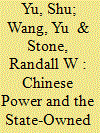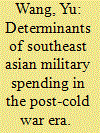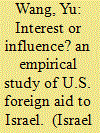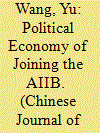|
|
|
Sort Order |
|
|
|
Items / Page
|
|
|
|
|
|
|
| Srl | Item |
| 1 |
ID:
183780


|
|
|
|
|
| Summary/Abstract |
China has become a leading source of outward foreign direct investment (FDI), and the Chinese state exercises a unique degree of influence over its firms. We explore the patterns of political influence over FDI using a comprehensive firm-level data set on Chinese outward FDI from 2000 to 2013. Using six country-level measures of affinity for China, we find that state-owned and globally diversified firms appear to conform most closely to official guidance. Official investment directives and state visits link investments to state policies; Taiwan recognition and Dalai Lama meetings anchor our political interpretations; and UN General Assembly voting and temporary UN Security Council membership suggest that this intervention may be systematic. The results are robust to country, year, and sector fixed effects, and most do not hold for private or small firms. The results suggest that China uses FDI by prominent state-owned enterprises as an instrument to promote its foreign policy.
|
|
|
|
|
|
|
|
|
|
|
|
|
|
|
|
| 2 |
ID:
117691


|
|
|
|
|
| Publication |
2013.
|
| Summary/Abstract |
This study examines the demand of military expenditure among Southeast Asian countries since the end of the Cold War. By using a dynamic panel approach, I find that military spending in the region has been jointly determined by economic, strategic and socio-political factors. In particular, surging foreign debt burdens and the rise of China - two regional issues that gained prominence in the post-Cold War period - show their significance as determinants along with other generalist variables. The results therefore ask for the development of even-handed and region-sensitive approaches to studying military build-up in the region of Southeast Asia.
|
|
|
|
|
|
|
|
|
|
|
|
|
|
|
|
| 3 |
ID:
176745


|
|
|
|
|
| Summary/Abstract |
Although many new nuclear power plant (NPP) projects, such as the addition of a new reactor, have been proposed at the locations of existing nuclear installations, little attention has been given to research on the acceptance of such rebuilding projects by local residents living near the existing NPPs. The present study develops a theoretical model that examines the influences of environmental concern, place attachment, perceived benefit, and perceived risk on local acceptance of rebuilding NPPs. The study also divides perceived benefit into two dimensions, namely, perceived general benefit and perceived local benefit. Using data from an online questionnaire-based survey in China, the results indicate that for the surveyed local residents, rebuilding acceptance is positively influenced by perceived local benefit and perceived general benefit but is negatively affected by perceived risk. Perceived local benefit is the dominant factor influencing local rebuilding acceptance. Contrary to expectations, environmental concern positively affects the perceived benefit, which in turn positively affects local rebuilding acceptance. Moreover, place attachment positively affects the perceived benefit and negatively affects the perceived risk, which in turn positively affects local rebuilding acceptance. Based on these findi
|
|
|
|
|
|
|
|
|
|
|
|
|
|
|
|
| 4 |
ID:
128042


|
|
|
|
|
| Publication |
2014.
|
| Summary/Abstract |
This study offers an investigation of the relationship between defense and social spending in the People's Republic of China. In particular, three consecutive questions are answered here. Does a warfare-welfare tradeoff exist in China's budgetary allocation? Is it positive or negative? What is the causal direction involved? By applying a vector autoregression analysis for the period of 1952-2006, this study finds a unidirectional crowd-out effect going from defense to social spending.
|
|
|
|
|
|
|
|
|
|
|
|
|
|
|
|
| 5 |
ID:
180044


|
|
|
|
|
| Summary/Abstract |
Research on the determinants of U.S. foreign aid to Israel is commonly motivated by two contesting theoretical paradigms. Pioneered by Organski, the self-interest paradigm conceptualises aid as a mutually beneficial deal that helps the U.S. to advance its interest in the Middle East. The influence paradigm, best showcased by Mearsheimer and Waltz, views U.S. aid to Israel as a corollary of the overwhelming influence of pro-Israel interest groups on U.S. foreign policy decision-making. This article attempts to shed new light on the debate by using systematic data analysis. The results show consistent evidence in support of the self-interest paradigm.
|
|
|
|
|
|
|
|
|
|
|
|
|
|
|
|
| 6 |
ID:
160240


|
|
|
|
|
| Summary/Abstract |
This article analyzes the determinants of new prospective members of the Asian Infrastructure Investment Bank (AIIB). I argue that less democratic countries are more likely to apply, and that when deciding to join the institution countries learn from their neighbors and from any previous international organization (IO) interactions they have had with China. Building on detailed panel data covering the institution’s founding period, i.e. from October 24, 2014 to March 31, 2015, I fit both a probit model with time polynomials and a Cox duration model to identify country characteristics that correlate with joining the AIIB. I show that countries with lower polity scores or whose neighbors had already become members were more likely to join, and that the probability was higher for countries that belonged to China-led IOs. Lastly, I show that countries under-represented in the existing international financial system were also more likely to join. My findings highlight the importance of democracy in shaping the membership structure of the AIIB, and demonstrate how countries leverage information from their neighbors and from previous interactions with China to adjust the perceived risk of joining. They also provide the first modern-day empirical support for the contested multilateralism framework.
|
|
|
|
|
|
|
|
|
|
|
|
|
|
|
|
| 7 |
ID:
116908


|
|
|
|
|
| Publication |
2012.
|
| Summary/Abstract |
China is the largest energy consumer and CO2 emitter in the world. The Chinese government faces growing challenges of ensuring energy security and reducing greenhouse gas emissions. To address these two issues, the Chinese government has announced two ambitious domestic indicative autonomous mitigation targets for 2020: increasing the ratio of non-fossil energy to 15% and reducing carbon dioxide emissions per unit of GDP by 40-45% from 2005 levels. To explore the role of non-fossil energy in achieving these two targets, this paper first provides an overview of current status of non-fossil energy development in China; then gives a brief review of GDP and primary energy consumption; next assesses in detail the role of the non-fossil energy in 2020, including the installed capacity and electricity generation of non-fossil energy sources, the share and role of non-fossil energy in the electricity structure, emissions reduction resulting from the shift to non-fossil energy, and challenges for accomplishing the mitigation targets in 2020; finally, conclusions and policy measures for non-fossil energy development are proposed.
|
|
|
|
|
|
|
|
|
|
|
|
|
|
|
|
| 8 |
ID:
125547


|
|
|
|
|
| Publication |
2013.
|
| Summary/Abstract |
China is experiencing rapid motorization and each city has a unique motorization pathway owing to its different characteristics and development progress. The temporal and spatial variation trend in on-road energy use and CO2 emissions need to be better understood in order to project the future growth and to support policy-making at both local and national levels. This study simulates the on-road energy use and CO2 emissions of all of China's prefectural-level cities (and above) from 1978 through 2008, on the basis of the collected vehicle data from hundreds of national and local statistical yearbooks. The results show that China's on-road energy use and CO2 emissions were 119 million metric tons (MMT) and 377 MMT in 2008, respectively-20 times the levels in 1978. The economically developed cities and heavy industrial cities had the highest on-road energy use and CO2 emissions before the year 2000, but recently the spatial distribution has varied significantly as the uptake of motorization increases successively in these cities. Now and in the near future, the most important driving force of the on-road energy and CO2 growth in China is the great number of average cities that have just started or will soon start the motorization.
|
|
|
|
|
|
|
|
|
|
|
|
|
|
|
|
|
|
|
|
|